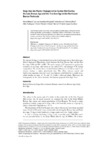Mostrar o rexistro simple do ítem
Dogs that Ate Plants: Changes in the Canine Diet During the Late Bronze Age and the First Iron Age in the Northeast Iberian Peninsula
| dc.contributor.author | Albizuri, Silvia | |
| dc.contributor.author | Grandal-d'Anglade, Aurora | |
| dc.contributor.author | Maroto, Julià | |
| dc.contributor.author | Oliva, Mònica | |
| dc.contributor.author | Rodríguez, Alba | |
| dc.contributor.author | Terrats, Noemí | |
| dc.contributor.author | Palomo Pérez, Antoni | |
| dc.contributor.author | López-Cachero, F. Javier | |
| dc.date.accessioned | 2024-01-03T10:52:34Z | |
| dc.date.available | 2024-01-03T10:52:34Z | |
| dc.date.issued | 2021-03-25 | |
| dc.identifier.citation | Albizuri, S., Grandal-d’Anglade, A., Maroto, J. et al. Dogs that Ate Plants: Changes in the Canine Diet During the Late Bronze Age and the First Iron Age in the Northeast Iberian Peninsula. J World Prehist 34, 75–119 (2021). https://doi.org/10.1007/s10963-021-09153-9 | es_ES |
| dc.identifier.issn | 1573-7802 | |
| dc.identifier.uri | http://hdl.handle.net/2183/34735 | |
| dc.description | This is an Accepted Version of the article: this version of the article has been accepted for publication, after peer review (when applicable) and is subject to Springer Nature’s AM terms of use, but is not the Version of Record and does not reflect post-acceptance improvements, or any corrections. The Version of Record is available online at: https://doi.org/10.1007/s10963-021-09153-9 | es_ES |
| dc.description.abstract | [Abstract] We studied 36 dogs (Canis familiaris) from the Can Roqueta site in the Catalan pre-littoral depression (Barcelona), dated between the Late Bronze Age and the First Iron Age (1300 and 550 cal BC). We used a sample of 27 specimens to analyse the evolution of the dogs’ diet based on the carbon δ13C and nitrogen δ15N isotope composition. The results show a marked human influence in that these natural carnivores display a highly plant-based diet. The offset between canids and herbivorous ungulates does not reach the minimum established for a trophic level, which implies an input of C3 and C4 (millet) cultivated plants. Moreover, the homogeneity in the values indicates that humans prepared their dogs’ food. | es_ES |
| dc.description.sponsorship | This paper was written as part of the research undertaken by the consolidated research group SGR2017-00011 Seminari d’Estudis I Recerques Prehistòriques (SERP) and within the Projects HAR2013-48010-P and HAR2017-87695-P funded by the Spanish Ministry of Economy and Competitiveness. We want to thank the reviewers of this paper because their insights have helped improve the work | es_ES |
| dc.description.sponsorship | Cataluña. Generalitat; SGR2017-00011 | es_ES |
| dc.language.iso | eng | es_ES |
| dc.publisher | Springer | es_ES |
| dc.relation | info:eu-repo/grantAgreement/MINECO/Plan Estatal de Investigación Científica y Técnica y de Innovación 2013-2016/HAR2013-48010-P/ES/MOVILIDAD, CONTACTOS E INTERCAMBIOS DURANTE EL BRONCE FINAL Y EL HIERRO I EN EL NORDESTE PENINSULAR: EL RIO RIPOLL (BARCELONA) COMO LABORATORIO/ | es_ES |
| dc.relation | info:eu-repo/grantAgreement/AEI/Plan Estatal de Investigación Científica y Técnica y de Innovación 2017-2020/HAR2017-87695-P/ES/FAMILIAS, VECINOS Y FORASTEROS EN LA PREHISTORIA RECIENTE DEL PRELITORAL CATALAN/ | es_ES |
| dc.relation.uri | https://doi.org/10.1007/s10963-021-09153-9 | es_ES |
| dc.subject | Iberian Peninsula | es_ES |
| dc.subject | Dogs | es_ES |
| dc.subject | Diet evolution | es_ES |
| dc.subject | Human control | es_ES |
| dc.subject | Late Bronze Age | es_ES |
| dc.subject | Early Iron Age | es_ES |
| dc.title | Dogs that Ate Plants: Changes in the Canine Diet During the Late Bronze Age and the First Iron Age in the Northeast Iberian Peninsula | es_ES |
| dc.type | info:eu-repo/semantics/article | es_ES |
| dc.rights.access | info:eu-repo/semantics/openAccess | es_ES |
| UDC.journalTitle | Journal of World Prehistory | es_ES |
| UDC.volume | 34 (2021) | es_ES |
| UDC.startPage | 75 | es_ES |
| UDC.endPage | 119 | es_ES |
| dc.identifier.doi | 10.1007/s10963-021-09153-9 |
Ficheiros no ítem
Este ítem aparece na(s) seguinte(s) colección(s)
-
IUX-CULXEO - Artigos [48]






